How to Remove Credit Card Processing Fees in WordPress
Last updated on
Do you want to remove the credit card processing fees for online payments?
Stripe, like any other payment processors, charges a fee for processing credit card payments. With WP Simple Pay, you can let users cover the processing fee, so you can collect the full amount for the payments you accept on your WordPress site.
In this article, we’ll show you how to remove credit card processing fees in WordPress.
Offset Credit Card Processing Fees in WordPress
Stripe charges different credit card processing fee based on where you’re located at. If you’re based in the United States, for example, Stripe collects 2.9% + 30¢ per successful card charge.
That means when you collect a $10.00 donation or payment, you only earn $9.41 and Stripe takes the rest as the processing fee if the payment is made through credit card.
In fact, the processing fees also vary based on the payment method your users choose for making the payment.
If only there is a tool that makes it easy for you to let users cover the processing fees?
You’re at the right place. WP Simple Pay, the best Stripe payment plugin for WordPress, lets you recover the Stripe fees by passing processing fees to your users.
Here are a few benefits of WP Simple Pay’s Fee Recovery feature.
- Receive the full amount by letting users pay the processing fees. You can customize how much you can collect as fees.
- Collect different processing fees for different payment methods. This way, you can encourage users to choose a cheaper payment method.
- Force everyone to pay the processing fees or provide an option for users to pay the fee only if they’re willing to pay it while making payments.
Here’s the payment form we’re going to create with this tutorial.

Step 1: Install and Activate WP Simple Pay
To remove credit card processing fees in WordPress, the first thing you’ll need to do is to install and activate WP Simple Pay on your site.
After purchasing the WP Simple Pay plugin, download it from your purchase email receipt or from your WP Simple Pay account.
To install it, go to your WordPress backend, navigate to Add New under Plugins, and then Upload Plugin. Click Choose File and find the WP Simple Pay .zip file on your computer. Click Install Now. When the upload is complete, press the Activate Plugin button.
If you want to install WP Simple Pay via FTP, follow this guide.
Remove the additional 3% fee!
Most Stripe plugins charge an additional 3% fee for EVERY transaction
…not WP Simple Pay Pro!
After activating the plugin, you’ll be directed to the setup wizard. The setup wizard will walk you through to Stripe integration process. Click Let’s Get Started.
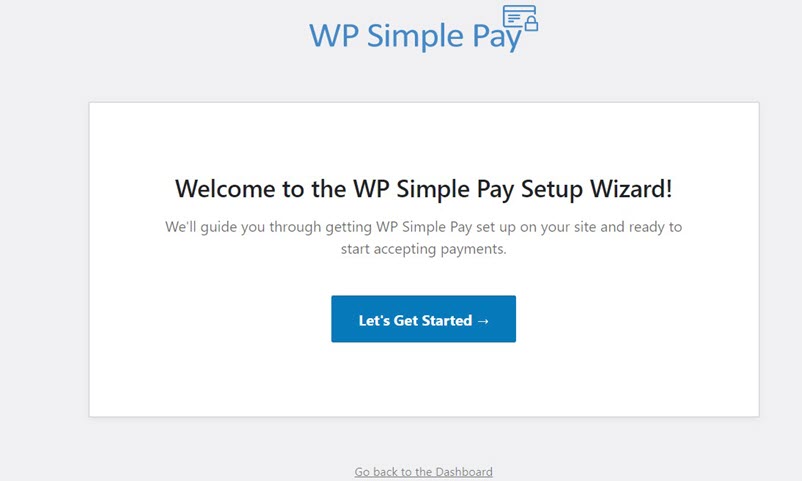
If you didn’t see the setup wizard, simply head over to WP Simple Pay » Settings and then click on the Stripe tab, where you can find the Connect with Stripe button. Just click on it to connect your Stripe account to your site.
Step 2: Connect WordPress to Stripe
Now you’ll be prompted to set up a new Stripe account or connect an existing account to your site. Click Connect with Stripe.

Next, enter your email address and start integrating your Stripe account with your site. Let’s NOT use Skip this form, unless you’re setting up WP Simple Pay for a test site. Enabling this option will create a temporary Stripe account that cannot be recovered or moved to Live Mode.
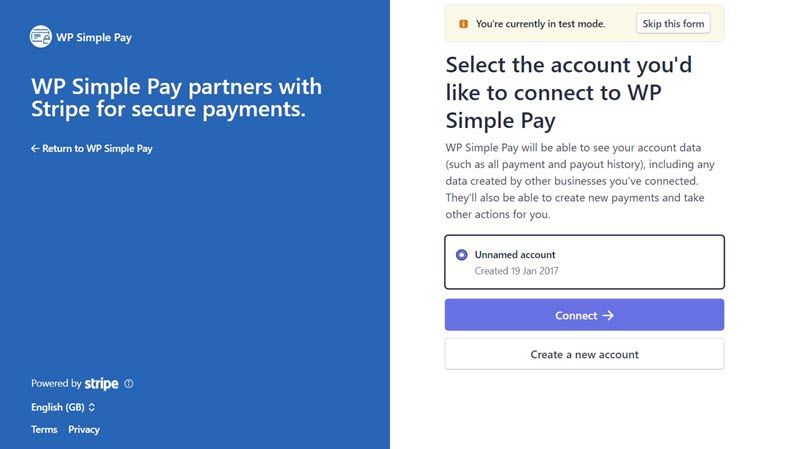
Upon completing this process, you’ll be shown a success page that says Setup Complete. To create a payment form that let users pay the processing fee, click on the button Create a Payment Form.

Step 3: Create a Payment Form
Now that you’ve connected your site to Stripe it’s your turn to create a payment form.
To create a form, you’ll need to select from a bunch of pre-built templates. Each template preselects certain options out of the box to make it easy to build a form. In this tutorial, we’ll select the Payment Form template.
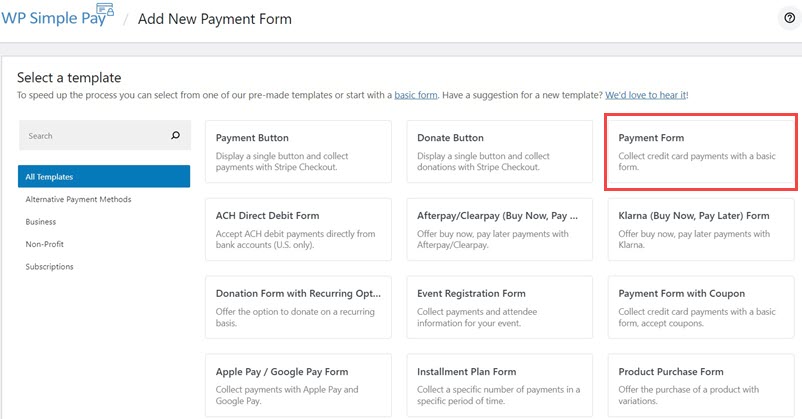
Step 4: Configure the Form to Accept Payments
Once you select your preferred template, you’ll be navigated to the General configuration page. Here you can specify the title, description, type, and more.

For more details, check out this post on selecting the right payment form types.
Next, click on the Payment option from the left. In this page, you can customize the currency, amount, and even choose between one-time and subscription payment.
Now scroll down the page until you see Payment Methods. You can see different payment methods that are available in your Stripe account’s country. To remove the credit card processing fee, click the Configure option, next to Card. Now a modal popup will show up, which prompting you to add an additional fee to payment.
Select the checkbox Add an additional fee to payments made with this payment method. If you reside in the United States, Stripe collects 2.9% + 30¢ per successful card charge. You can add the additional fees based on how much fee Stripe collects in your country for credit card processing.
Then click Update.
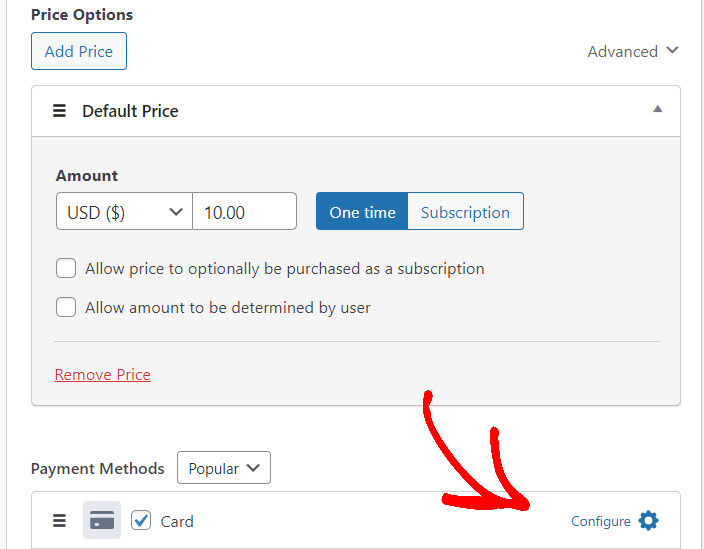
Next click on the Form Fields option on the left. In this page, you can add, remove or customize any existing form fields.
Since you’re collecting additional fees, you’d better off showing the amount breakdown in your payment form. That way your users can figure out you’re charging them an additional fee to the payment as the processing fee.
To show the amount breakdown, choose the field Amount Breakdown in the dropdown and click Add Field.
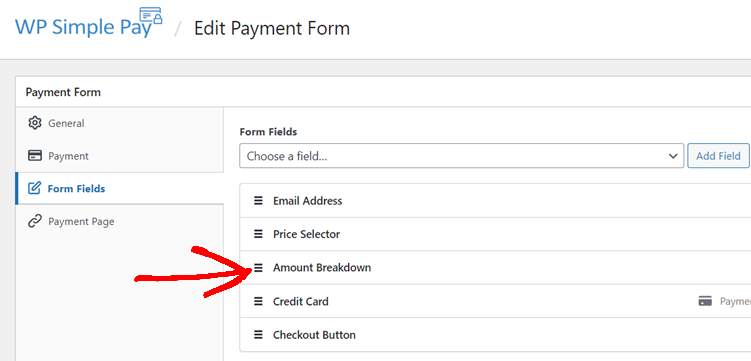
Here’s how the Amount Breakdown field will look like in your live form.

Step 5: Allow Users to Pay the Processing Fee
Wondering whether forcing your users to pay the processing fee will backlash?
No worries! With WP Simple Pay, you can add a toggle to allow users to opt-in to covering the processing fee.
This is a GREAT option especially for accepting online donations for non-profits. By offering this option in your donation form, your donors can cover the processing fee while also ensuring the entire donation they make actually goes to your non-profit and contributes to the cause they believe in.
To add the toggle to cover the processing fee, choose Fee Recovery Toggle in the dropdown and click the Add Field button.
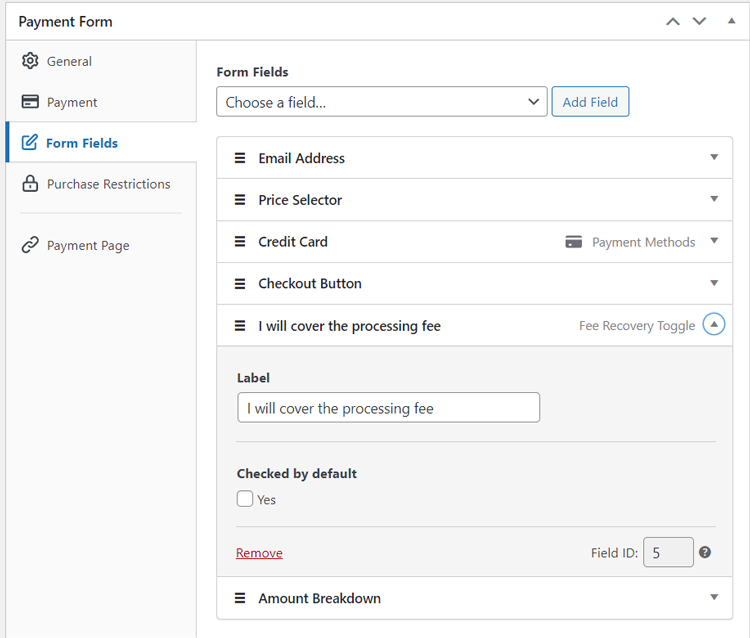
Feel free to change the label per your needs.
Here’s how your payment form will look with the fee recovery toggle.

There you have it!
Your payment form is now ready to accept payments. Publish the form and make some test payments (read more about Test mode). If the form works as intended, then it’s time to embed your form on the live site.
Step 6: Add the Payment Form to a Page
To embed your form on your live site, go to the post or page where you want to publish the form.
Then click on the + icon to add the WP Simple Pay block. Then choose a form you just created. And then, click Publish or Update.
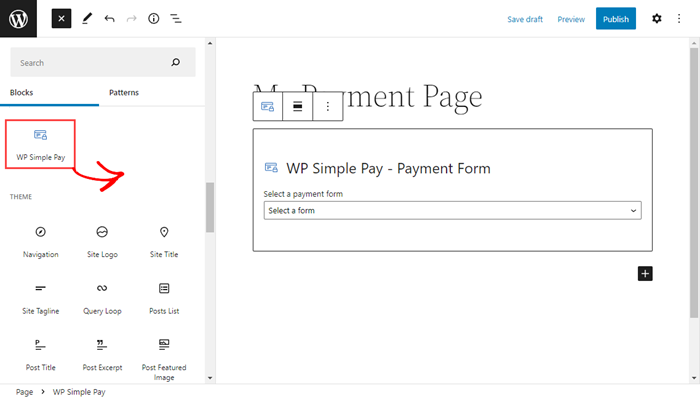
That’s it!
We hope this article helped you learn how to remove credit card processing fees in WordPress.
Aside from covering credit card processing fees, WP Simple Pay also lets you collect tax for online payments. Check out how to collect tax for payments in WordPress.
Get started with WP Simple Pay today!
To read more articles like this, follow us on Facebook and Twitter.
Disclosure: Our content is reader-supported. This means if you click on some of our links, then we may earn a commission. We only recommend products that we believe will add value to our readers.
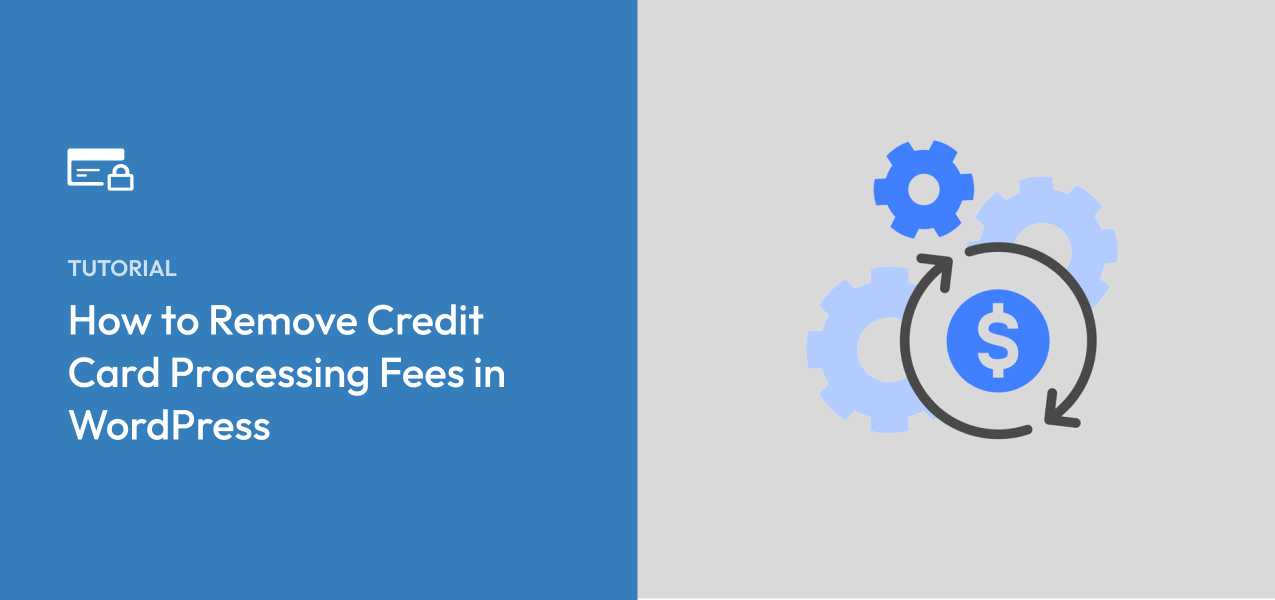


Leave a Reply